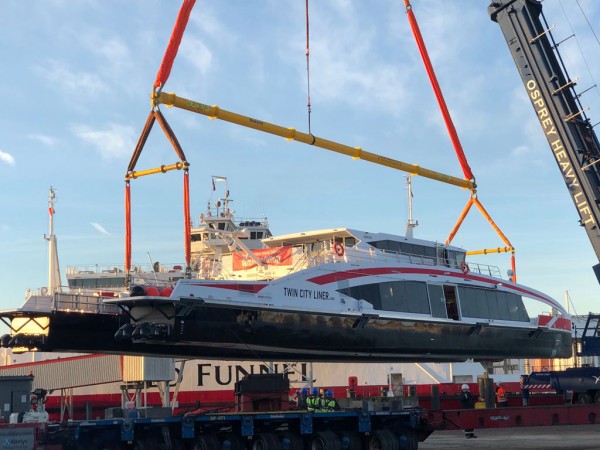UK-based Osprey Ltd., a specialist in the onshore and offshore transportation and lifting of heavy or abnormal loads, lifted a 72.5t catamaran using a 1,000t capacity Liebherr mobile crane and a one-over-two Modulift spreader beam configuration beneath its hook. The rigging gear was sourced from FLG Services, the specialist lifting division of A-Plant.
Osprey accepted a scope of work from shipbuilder Wight Shipyard to move the vessel from the shed where it was built to the water at Venture Quays, Cowes on the Isle of Wight, before a course was set for its final destination in Austria. The 250-passenger Twin City Liner is 39.7m long, 11.1m wide, and 6.8m high.

Danny Skidmore, heavy cranes manager at Osprey, said: “We had to work closely with shipbuilders and naval architects, and refer to CAD [computer-aided design], to devise a method of lifting the catamaran safely and completely level. The previous time we lifted such a vessel, we used two cranes in tandem, but mobilising two cranes of that size represents a large-scale operation and high costs, not to mention the disruption it has on the shipyard. We wanted to come up with a way to minimise mobilisation and limit the impact on our client’s busy, marine environment.”
Uncharted waters
Osprey consulted Modulift and FLG Services, principally on utilisation of the MOD400 at 29m, which usually has a maximum span of 24m. Sue Spencer, technical director at Modulift, said: “It was more cost effective and convenient for Osprey to source the beam from a rental partner versus a custom designed product. Our technical team looked into the feasibility, and came up with a solution whereby a central support sling system would be required to support the self-weight of the main spreader beam to minimise any potential deflection—and this adjustable sling system would need to be attached vertically to the crane hook.”
She added: “We devised a design whereby the tension load in the central sling could be monitored using a wireless load link to ensure that the sling was carrying the correct share of the self-weight of the beam throughout the lift, with the means to adjust the tension by way of a chain block. The customer monitored the tension throughout the lift to ensure that it did not go outside specified parameters. We attended the lift on an advisory basis to make sure everything went smoothly. We have not undertaken this type of rig before, and now we will be able to market our MOD250s and 400s at longer spans with a central support.”
Shaun Sullivan, of FLG Services, said: “Having the backup of Modulift throughout this process gave us confidence in the capabilities of the equipment in our fleet and will allow us to push boundaries in future projects.”
Skidmore concluded: “I was very impressed with the support provided by Modulift and FLG Services. They know the industry and get what we do. The positive, ‘can-do’ attitude will always go a long way with me.”

Follow us on social media: